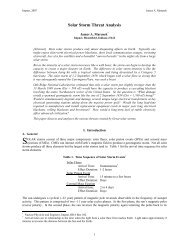THE COSMIC CLOCK, THE CYCLE OF TERRESTRIAL ... - Impact
THE COSMIC CLOCK, THE CYCLE OF TERRESTRIAL ... - Impact
THE COSMIC CLOCK, THE CYCLE OF TERRESTRIAL ... - Impact
You also want an ePaper? Increase the reach of your titles
YUMPU automatically turns print PDFs into web optimized ePapers that Google loves.
2 nd International Conference on Global Warming and the Next Ice Age (2006) TP-10<br />
tube NM-64 neutron detector array in Thule, Greenland. The monitoring station is located at 76.5 N latitude, 68.7<br />
W longitude and resides at an elevation of 26 meters. A severe storm passed through Thule, Greenland on 18-20<br />
February 2005. During the storm, a pressure drop of 39.5 mm Hg was observed which resulted in a 44.8% increase<br />
in detected neutrons. Refer to Figure 3. Neutrons are produced by collisions of cosmic rays with the atmosphere.<br />
The neutron counts are indicative of GCR penetration depth.<br />
A causal relationship may exist between the development of low barometric systems and the increased<br />
ionization of marine aerosols at the ocean’s surface.<br />
T<br />
VI. Strong Updrafts<br />
he development of strong updrafts is one of the observed parameters used by hurricane forecasting experts to<br />
predict hurricane intensification.<br />
Hot towers are tall precipitation towers in the hurricane’s eye wall. They produce rain clouds at the top of the<br />
troposphere reaching approximately 15 kilometers. Recent research by Kelley et al. [2005] showed hurricane<br />
intensification was related to the development of hot towers. If the frequency of tall precipitation in the eye wall is<br />
at least 33%, there is an 82% chance of wind intensification. Otherwise intensification drops very dramatically.<br />
As a tropical depression<br />
transforms into a hurricane, the<br />
action is no longer limited to the<br />
ocean’s surface. Warm moist<br />
marine aerosols are uplifted from<br />
sea level to heights ~ 15<br />
kilometers. The exposure of the<br />
marine aerosols to cosmic rays at<br />
these elevations produces<br />
exposure rates ~ 2,000 times<br />
greater compared to the exposure<br />
rates at the ocean’s surface. Refer<br />
to Figure 4. Since aerosol<br />
nucleation is a function of ion<br />
density, GCR induced ionization<br />
can explain the rapid expansion of<br />
the cloud structure that feeds<br />
hurricane growth.<br />
A causal relationship may<br />
exist between strong updrafts and<br />
the growth of the cloud structure<br />
that supports hurricane<br />
development. This process may also create a feedback loop where great updrafts that pull marine aerosols to<br />
extreme heights (e.g., 15 kilometers) increases the hurricanes wind speed which in turn causes a greater release of<br />
marine aerosols that feeds the expansion of the hurricane cloud structure.<br />
Figure 4. The solid line show vertical flux of cosmic rays<br />
(protons, neutrons) in the atmosphere with energy above 1<br />
GeV. [Yao et al., 2006]<br />
[As a sidebar, GCR ionization may also explain the effectiveness of cloud seeding programs. Hygroscopic<br />
cloud seeding programs infuse salt crystals (calcium chloride) into the cloud base. Strong updrafts pull the crystals<br />
up into the clouds where the salt dissolves into the cloud moisture. These salt water aerosols are exposed to GCR<br />
induced ionization which enhance aerosol nucleation and cloud growth & lifetime.]<br />
W<br />
VII. Strong Surface Winds<br />
ind speed is an observed parameter used by hurricane forecasters to define hurricane intensity. Storms grow<br />
from tropical depressions with sustained winds of less than 17 m/s; into tropical storms with sustained wind<br />
speeds of 17-32 m/s; into hurricanes with sustained wind speeds greater than 33 m/s.<br />
The increasing ocean surface wind speeds release a strong positive feedback loop. The production rate of<br />
marine aerosols is a function of the cube of the wind speed. The increasing surface wind speed release ever<br />
increasing marine aerosols that feed storm development. Without the higher surface winds, aerosol production will<br />
be limited and unavailable to interact within the GCR ionization process.<br />
A causal relationship may exist between increased ocean level wind speeds and increased marine aerosol<br />
production that feeds hurricane cloud production.<br />
4




